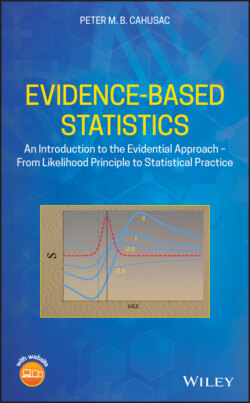Читать книгу Evidence-Based Statistics - Peter M. B. Cahusac - Страница 14
1.1 Evidence-Based Statistics
ОглавлениеScience advances from evidence, and scientific evidence guides decision-making, practice, and policy. Evidence-based practice encompasses numerous fields: policy, design, management, medicine, education, etc. In medicine, practitioners and patients alike rightly demand and expect that treatments used are evidence-based. To say that the use of a particular therapy is evidence-based means that it has sufficient evidence to support the benefit of its use compared with other possible treatments.
In science, data is obtained in many different ways depending on the methodology. Often the methodology is dictated by the constraints peculiar to the research area. Data can provide evidence on a number of different levels. It may be anecdotal, may come from observational, or from experimental studies. Anecdotal evidence is regarded as the weakest, although it may be the starting point for more systematic research. At the next level, multiple observations provide observational evidence which is usually correlational in nature. A carefully designed study, such as randomized controlled trial, can provide causal evidence for the effectiveness of a treatment. Finally, taking evidence from many research studies may be achieved by carrying out meta-analyses and systematic reviews. Each level in the pyramid of evidence has its advantages and drawbacks.
Appropriate statistical practice is fundamental to doing good science. This book is different from most statistical texts. It is an introduction to the likelihood approach and provides practical instructions on how to convert data into statistical evidence. It uses the likelihood approach that is fully objective in producing statistical results that depend only on the observed data. As Taper and Lele said ‘…the use of the likelihood ratio as an evidence measure is that only the models and the actual data are involved. This is quite different from the classical frequentist and error-statistical approaches, where the strength of evidence is the probability of making an error, calculated over all possible configurations of potential data’ [1, p. 538].
The likelihood approach encompasses a range of techniques grounded in established statistical theory. These techniques allow us to express relative evidence as a ratio of likelihoods. The phrases evidential approach and likelihood approach will be used interchangeably. Using the evidential approach frees us from dependence on the subjective considerations that bedevil other approaches. Based only upon observed evidence, it always informs us correctly about the relative strength of evidence for one hypothesis versus another.
A fuller discussion of the difficulties with approaches associated with p values is relegated to Appendix C.
